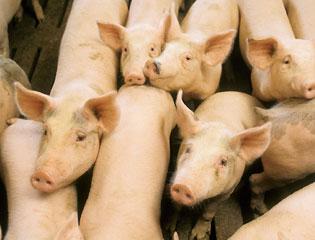Pestivirus suis (ICTV 2023)
Classical swine fever (CSF), hog cholera
Origin unknown; may be native to the U.S. (Ganges et al. 2020)
First reported in Tennessee in 1810; Eradicated in the U.S. in 1978 (Brown and Bevins 2018; Ganges et al. 2020)
Can be transmitted through contact with infected pigs or consumption of contaminated feed (Ganges et al. 2020)
Highly contagious, viral disease of pigs that is usually fatal. The disease is still present in many countries, so there is a risk that it could become established in this country once again. While classical swine fever does not cause foodborne illness in people, economic losses to pork producers would be severe if the disease were to become established again in this country. (Brown and Bevins 2018)
Not currently established

Classic swine fever, ARS discoveries are providing vital information to help fight this economically devastating disease, which affects cattle and other cloven-hoofed animals. Photo by Regis Lefebure; USDA, ARS, Image Gallery
All Resources
Selected Resources
The section below contains highly relevant resources for this species, organized by source.
Partnership
Federal Government
State and Local Government
Professional
Brown V.R., and S.N. Bevins. 2018. A review of classical swine fever virus and routes of introduction into the United States and the potential for virus establishment. Frontiers in Veterinary Science 5:31.
Ganges, L., H.R. Crooke, J.A. Bohórquez, et al. 2020. Classical swine fever virus: the past, present and future. Virus Research 289:198151.
ICTV. 2023. Pestivirus suis. Virus Taxonomy: 2023 Release, MSL #39.
